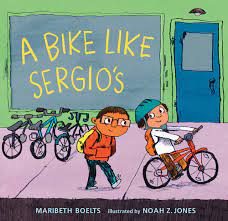Maribeth Boelts, author of more than 40 children’s books including Kaia and the Bees and A Bike Like Sergio’s, will be the featured reader at the Final Thursday Reading Series on October 28 where she will read from several of her publications. One of her most recent stories stems from a memory of her son, Will, while the characters were created out of her grandson’s want for a story with a stickbug and a beetle—and so the Stickbug and Beetle story in The Purple Puffy Coat begins.
The event takes place in the Mae Latta room in the Hearst Center for the Arts. A creative writing open mic starts at 7:00 p.m. (sign up to read your best five minutes of original work), and Boelts's featured reading will begin at 7:30 p.m. The featured reading will be Zoomcast live at 7:30 Central time. You can register for that HERE.
The following interview with Maribeth Boelts, detailing her work in children's literature and her approach to writing, was conducted by Alexus Williams.
Alexus Williams: You have mentioned that you got involved in writing children’s stories after having your own kids, and now grandkids, but did you ever feel a calling towards children’s stories prior to that? If so, how did starting your own family change your feelings/motivation, if at all, for writing children’s stories?
Maribeth Boelts: I knew I wanted to be a writer when I was in second grade, and I lived for the creative writing blocks of time with zero instruction we were given in grade school. During high school, I wrote a little series of stories for children, and showed it to the old Catholic nun I had as an English teacher. She was enthusiastic, and that encouraged me. Once I graduated from college, and was teaching, I was constantly coming up with little stories and poems for the children I taught, and began to submit things to publishers here and there. My passion grew as we started having children, and we read countless stacks of picture books to them. That's when I quit my teaching job, and started exploring writing for children as a career. The motivation has always been there, really. I love children, and I've always been so curious about the stories that keep them turning the page or requesting multiple readings.
AW: Looking at the books you have written, you have certainly covered a wide variety of topics, settings, and characters. With that being said, where do you draw your inspiration from for these stories? Do you find your stories come from a place of necessity? (i.e. trying to explain certain concepts to your grandkids (or your kids when they were younger).
MB: For me, most of my stories begin with an "ache" of some sort-- a remembering of a childhood experience or emotion, that I sense has a universal thread in it. For example, a want that is out of reach. Or a common fear that requires some courage. Or a feeling of security and love that must have words wrapped around it. Or a friendship that asks for a selfless act. I try to be careful about teaching anything overtly, as children can sniff out a "good for you" book a mile away, but I do really like to get some discussion going with my books.
AW: What is the writing process like for you? Also, when do you begin to consider what kind of illustrations should be included in the books?
MB: I try to write at least something every day, but when I have an idea that seems to hold some promise, I will let it simmer for a while. I tend to write a first draft quickly and with as little self-consciousness or inner critic as possible. Just write fast and get the bare bones story down. If it appears that it has enough substance to continue, I will begin to flesh it out. This is my favorite stage of writing... with the pressure of the first draft under my belt, and the luxury of having something concrete to work with as I continue.
In terms of illustration, I leave that in the hands of the editors and art department at the publishers. While I imagine what the illustrations could look like, and I "see" the story in my head as it unfolds, I have little to do with the illustration of my stories. The illustrator has the freedom to interpret my text just as I had the freedom to create it.
AW: Have you considered writing other literature, like young adult literature? If so, what kind of literature crosses your mind? If not, could you explain why you would rather focus on children’s literature?
MB: I'm most intrigued by children's books, and though I do have a middle grade novel and will write more of those in the future, I haven't explored young adult literature beyond reading it. I find childhood infinitely interesting, and it remains a good challenge to write for this audience.
AW: Looking back at when you first started writing children’s stories, what is one thing you would tell your younger self?
MB: Expect to be surprised by the stories that "catch" and the stories that go unnoticed, and keep writing.



No comments:
Post a Comment